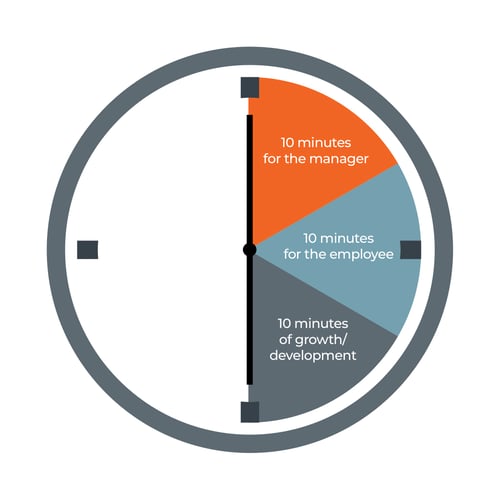Team Meetings Bring Your Employees Together
Reorganizations often result in new teams within a department, or a totally new makeup of an existing team. Employees within the teams may or may not be familiar with one another, and if you’re a new leader, they’re probably not familiar with you and your leadership style. Team meetings are a great way to bring the new team together, establish expectations and build camaraderie.
Create an agenda to help guide the discussion, including items such as:
- Updates on the organization—especially related to the aftermath of the recent change—and goings-on in the company. Employees like to hear news from their managers first.
- Specifics about what this change means for the team as a whole.
- Alignment of the team with common goals, especially around any corporate changes.
- Shout-outs to team members for wins and successes. Celebrate one another!
- The occasional inclusion of guest speakers from other teams to help increase employee knowledge about the whole organization.
- Open time for questions and discussion, and even some fun.
Team meetings should last between 30-60 minutes. Reserving a conference room for your team meeting allows employees to step away from their desks and get together without distraction (discourage the use of laptops and cellphones). If the team has remote members, regularly use video conferencing tools to help increase engagement. Find a video conferencing tool that works for your team, get to know it well to iron out any technical bugs or issues. Take notes and follow up on important items where the discussion extends beyond the meeting.
1:1 Meetings Let You Get to Know Your Employees Individually
1:1 meetings give the opportunity for open dialogue and communication between a manager and employee. This is especially important following a change that impacts an employee, allowing the manager to check in and ensure the employee does not have lingering concerns or anxieties.
With 1:1 meetings following a change, managers can:
- Discuss how the change could positively impact the team member’s career development and goals
- Explain how this change impacts the employee’s role directly (or indirectly)
- Stop potential issues before they fester into negative attitudes and performance
- Provide feedback on how the employee is handling or addressing the change
- Delegate any new tasks appropriately
Ultimately, 1:1 meetings should be seen as a way for leaders and employees to get to know one another. Employees will feel valued when given this attention, especially if they are unfamiliar with their new leader.
A good rule of thumb for using the time wisely is: 
Establishing an agenda, taking notes and following up on action items is critical to the effectiveness of 1:1 meetings. If you have an office, plan to conduct the 1:1 there with the door closed. Otherwise, reserve a conference room. A closed door can help limit distractions and give the meeting a sense of importance and focus.
Maintaining Consistency is Vital
When impactful organizational changes are happening, employees are looking for consistency in their day-to-day. By scheduling (and prioritizing) team and 1:1 meetings, leaders can help promote stability in the wake of change. Leaders can choose how to best schedule all of these meetings throughout a week or month, but the key factor is that they happen. A team meeting or 1:1 that is consistently cancelled by the leader could leave the team discouraged and feeling undervalued. The personal and professional connections established through consistent meetings will help employees at every level of an organization stay informed and invested during big transitions.
Change is never easy, and being a leader through change is even more difficult. Holding consistent team and 1:1 meetings gives you the opportunity to discuss with your employees what this news means for them. Communicating this information is a challenge large organizations face because it is difficult to convey in a broad announcement, but it’s usually the number one thing employees care about. Group and individual meetings will go a long way in helping you explain the individual and team impacts, establish connections, generate buy-in, and motivate your team to stay engaged throughout the transition.
Want to make the most of your 1:1 meetings? Click here to learn more.



